The 'If Not, Why Not' Approach in ASX Corporate Governance Principles
VerifiedAdded on 2020/05/16
|11
|2765
|156
AI Summary
The Australian Securities Exchange (ASX) Corporate Governance Principles incorporate a unique 'If Not, Why Not' approach, providing flexibility for listed companies to tailor their governance structures to specific circumstances. This article analyzes the implications of this approach on risk management and corporate accountability. It discusses how companies can leverage this flexibility while ensuring they adhere to best practices in governance. The analysis includes insights from various editions of the ASX Corporate Governance Principles and recommendations, highlighting changes over time and their impact on corporate governance frameworks.

qwertyuiopasdfghjklzxcvbnmqwertyui
opasdfghjklzxcvbnmqwertyuiopasdfgh
jklzxcvbnmqwertyuiopasdfghjklzxcvb
nmqwertyuiopasdfghjklzxcvbnmqwer
tyuiopasdfghjklzxcvbnmqwertyuiopas
dfghjklzxcvbnmqwertyuiopasdfghjklzx
cvbnmqwertyuiopasdfghjklzxcvbnmq
wertyuiopasdfghjklzxcvbnmqwertyuio
pasdfghjklzxcvbnmqwertyuiopasdfghj
Corporate Law
Individual Essay Writing
26-Jan-18
(Student Details: )
opasdfghjklzxcvbnmqwertyuiopasdfgh
jklzxcvbnmqwertyuiopasdfghjklzxcvb
nmqwertyuiopasdfghjklzxcvbnmqwer
tyuiopasdfghjklzxcvbnmqwertyuiopas
dfghjklzxcvbnmqwertyuiopasdfghjklzx
cvbnmqwertyuiopasdfghjklzxcvbnmq
wertyuiopasdfghjklzxcvbnmqwertyuio
pasdfghjklzxcvbnmqwertyuiopasdfghj
Corporate Law
Individual Essay Writing
26-Jan-18
(Student Details: )
Paraphrase This Document
Need a fresh take? Get an instant paraphrase of this document with our AI Paraphraser
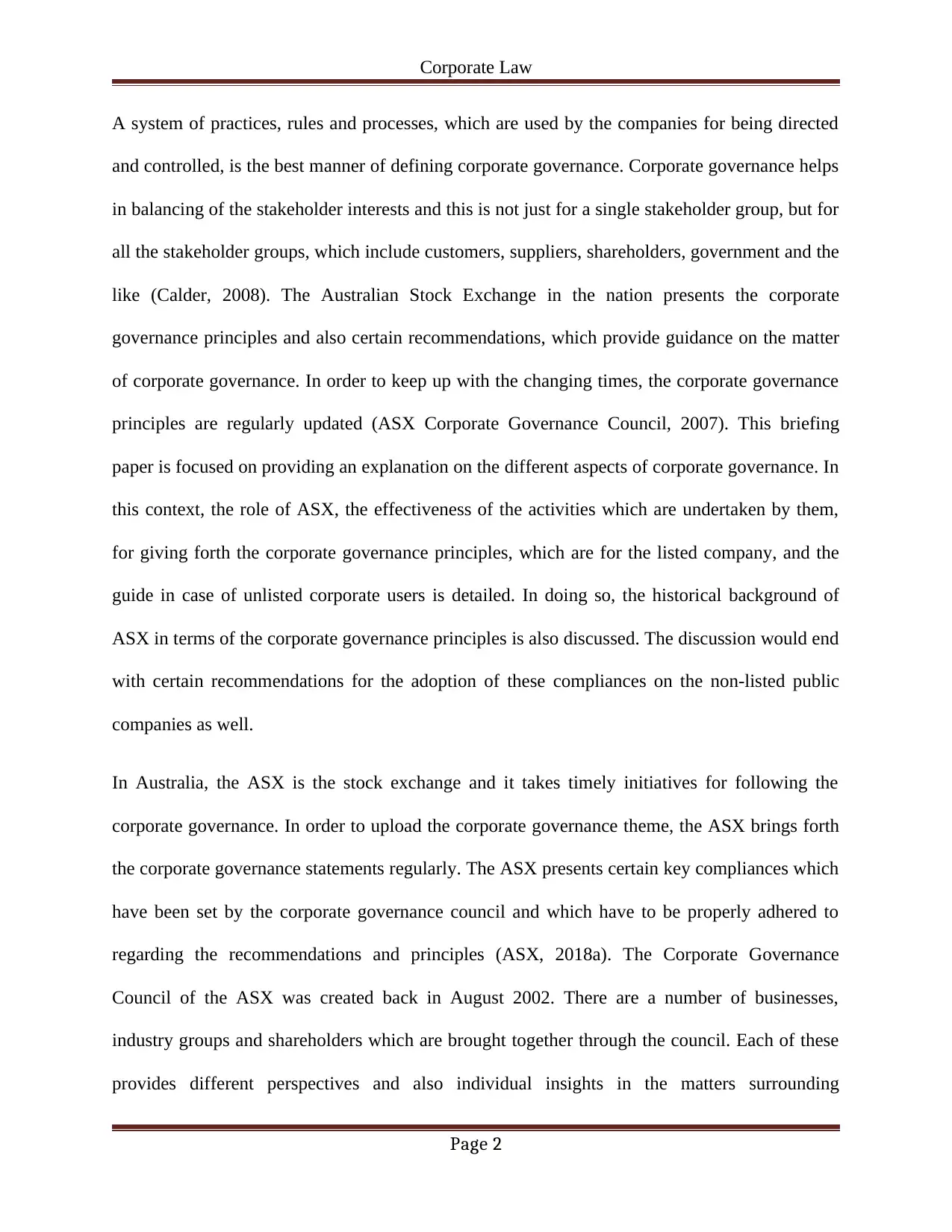
Corporate Law
A system of practices, rules and processes, which are used by the companies for being directed
and controlled, is the best manner of defining corporate governance. Corporate governance helps
in balancing of the stakeholder interests and this is not just for a single stakeholder group, but for
all the stakeholder groups, which include customers, suppliers, shareholders, government and the
like (Calder, 2008). The Australian Stock Exchange in the nation presents the corporate
governance principles and also certain recommendations, which provide guidance on the matter
of corporate governance. In order to keep up with the changing times, the corporate governance
principles are regularly updated (ASX Corporate Governance Council, 2007). This briefing
paper is focused on providing an explanation on the different aspects of corporate governance. In
this context, the role of ASX, the effectiveness of the activities which are undertaken by them,
for giving forth the corporate governance principles, which are for the listed company, and the
guide in case of unlisted corporate users is detailed. In doing so, the historical background of
ASX in terms of the corporate governance principles is also discussed. The discussion would end
with certain recommendations for the adoption of these compliances on the non-listed public
companies as well.
In Australia, the ASX is the stock exchange and it takes timely initiatives for following the
corporate governance. In order to upload the corporate governance theme, the ASX brings forth
the corporate governance statements regularly. The ASX presents certain key compliances which
have been set by the corporate governance council and which have to be properly adhered to
regarding the recommendations and principles (ASX, 2018a). The Corporate Governance
Council of the ASX was created back in August 2002. There are a number of businesses,
industry groups and shareholders which are brought together through the council. Each of these
provides different perspectives and also individual insights in the matters surrounding
Page 2
A system of practices, rules and processes, which are used by the companies for being directed
and controlled, is the best manner of defining corporate governance. Corporate governance helps
in balancing of the stakeholder interests and this is not just for a single stakeholder group, but for
all the stakeholder groups, which include customers, suppliers, shareholders, government and the
like (Calder, 2008). The Australian Stock Exchange in the nation presents the corporate
governance principles and also certain recommendations, which provide guidance on the matter
of corporate governance. In order to keep up with the changing times, the corporate governance
principles are regularly updated (ASX Corporate Governance Council, 2007). This briefing
paper is focused on providing an explanation on the different aspects of corporate governance. In
this context, the role of ASX, the effectiveness of the activities which are undertaken by them,
for giving forth the corporate governance principles, which are for the listed company, and the
guide in case of unlisted corporate users is detailed. In doing so, the historical background of
ASX in terms of the corporate governance principles is also discussed. The discussion would end
with certain recommendations for the adoption of these compliances on the non-listed public
companies as well.
In Australia, the ASX is the stock exchange and it takes timely initiatives for following the
corporate governance. In order to upload the corporate governance theme, the ASX brings forth
the corporate governance statements regularly. The ASX presents certain key compliances which
have been set by the corporate governance council and which have to be properly adhered to
regarding the recommendations and principles (ASX, 2018a). The Corporate Governance
Council of the ASX was created back in August 2002. There are a number of businesses,
industry groups and shareholders which are brought together through the council. Each of these
provides different perspectives and also individual insights in the matters surrounding
Page 2
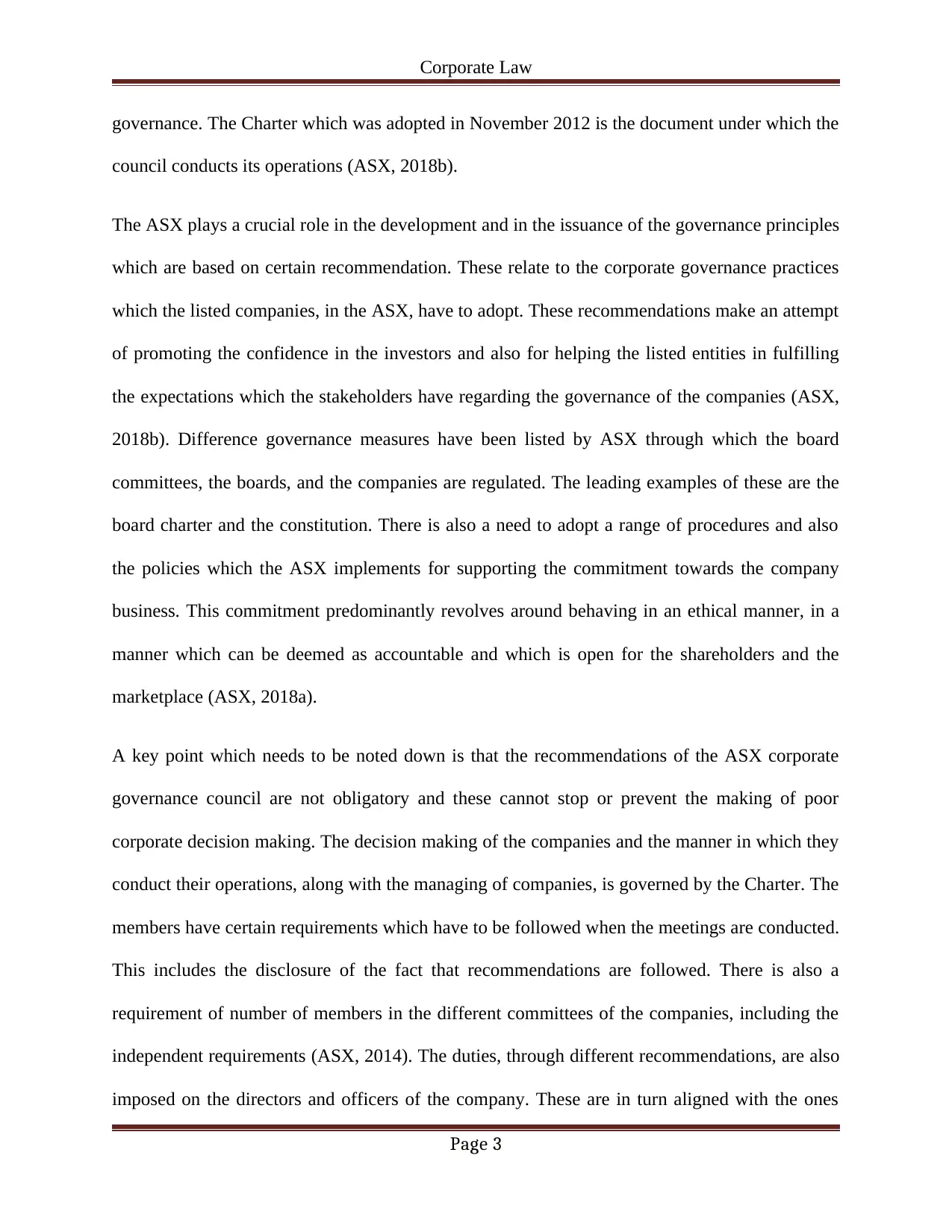
Corporate Law
governance. The Charter which was adopted in November 2012 is the document under which the
council conducts its operations (ASX, 2018b).
The ASX plays a crucial role in the development and in the issuance of the governance principles
which are based on certain recommendation. These relate to the corporate governance practices
which the listed companies, in the ASX, have to adopt. These recommendations make an attempt
of promoting the confidence in the investors and also for helping the listed entities in fulfilling
the expectations which the stakeholders have regarding the governance of the companies (ASX,
2018b). Difference governance measures have been listed by ASX through which the board
committees, the boards, and the companies are regulated. The leading examples of these are the
board charter and the constitution. There is also a need to adopt a range of procedures and also
the policies which the ASX implements for supporting the commitment towards the company
business. This commitment predominantly revolves around behaving in an ethical manner, in a
manner which can be deemed as accountable and which is open for the shareholders and the
marketplace (ASX, 2018a).
A key point which needs to be noted down is that the recommendations of the ASX corporate
governance council are not obligatory and these cannot stop or prevent the making of poor
corporate decision making. The decision making of the companies and the manner in which they
conduct their operations, along with the managing of companies, is governed by the Charter. The
members have certain requirements which have to be followed when the meetings are conducted.
This includes the disclosure of the fact that recommendations are followed. There is also a
requirement of number of members in the different committees of the companies, including the
independent requirements (ASX, 2014). The duties, through different recommendations, are also
imposed on the directors and officers of the company. These are in turn aligned with the ones
Page 3
governance. The Charter which was adopted in November 2012 is the document under which the
council conducts its operations (ASX, 2018b).
The ASX plays a crucial role in the development and in the issuance of the governance principles
which are based on certain recommendation. These relate to the corporate governance practices
which the listed companies, in the ASX, have to adopt. These recommendations make an attempt
of promoting the confidence in the investors and also for helping the listed entities in fulfilling
the expectations which the stakeholders have regarding the governance of the companies (ASX,
2018b). Difference governance measures have been listed by ASX through which the board
committees, the boards, and the companies are regulated. The leading examples of these are the
board charter and the constitution. There is also a need to adopt a range of procedures and also
the policies which the ASX implements for supporting the commitment towards the company
business. This commitment predominantly revolves around behaving in an ethical manner, in a
manner which can be deemed as accountable and which is open for the shareholders and the
marketplace (ASX, 2018a).
A key point which needs to be noted down is that the recommendations of the ASX corporate
governance council are not obligatory and these cannot stop or prevent the making of poor
corporate decision making. The decision making of the companies and the manner in which they
conduct their operations, along with the managing of companies, is governed by the Charter. The
members have certain requirements which have to be followed when the meetings are conducted.
This includes the disclosure of the fact that recommendations are followed. There is also a
requirement of number of members in the different committees of the companies, including the
independent requirements (ASX, 2014). The duties, through different recommendations, are also
imposed on the directors and officers of the company. These are in turn aligned with the ones
Page 3
⊘ This is a preview!⊘
Do you want full access?
Subscribe today to unlock all pages.

Trusted by 1+ million students worldwide
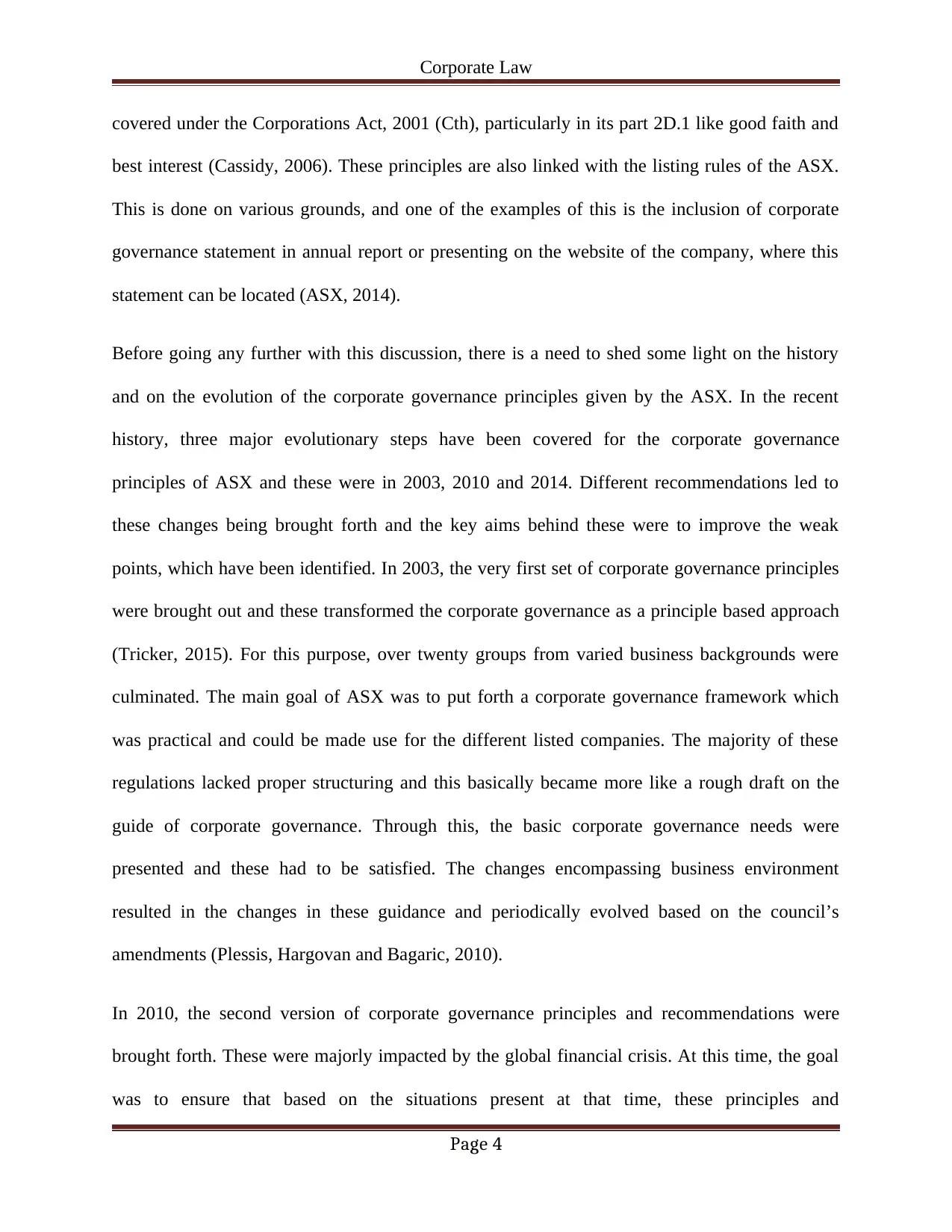
Corporate Law
covered under the Corporations Act, 2001 (Cth), particularly in its part 2D.1 like good faith and
best interest (Cassidy, 2006). These principles are also linked with the listing rules of the ASX.
This is done on various grounds, and one of the examples of this is the inclusion of corporate
governance statement in annual report or presenting on the website of the company, where this
statement can be located (ASX, 2014).
Before going any further with this discussion, there is a need to shed some light on the history
and on the evolution of the corporate governance principles given by the ASX. In the recent
history, three major evolutionary steps have been covered for the corporate governance
principles of ASX and these were in 2003, 2010 and 2014. Different recommendations led to
these changes being brought forth and the key aims behind these were to improve the weak
points, which have been identified. In 2003, the very first set of corporate governance principles
were brought out and these transformed the corporate governance as a principle based approach
(Tricker, 2015). For this purpose, over twenty groups from varied business backgrounds were
culminated. The main goal of ASX was to put forth a corporate governance framework which
was practical and could be made use for the different listed companies. The majority of these
regulations lacked proper structuring and this basically became more like a rough draft on the
guide of corporate governance. Through this, the basic corporate governance needs were
presented and these had to be satisfied. The changes encompassing business environment
resulted in the changes in these guidance and periodically evolved based on the council’s
amendments (Plessis, Hargovan and Bagaric, 2010).
In 2010, the second version of corporate governance principles and recommendations were
brought forth. These were majorly impacted by the global financial crisis. At this time, the goal
was to ensure that based on the situations present at that time, these principles and
Page 4
covered under the Corporations Act, 2001 (Cth), particularly in its part 2D.1 like good faith and
best interest (Cassidy, 2006). These principles are also linked with the listing rules of the ASX.
This is done on various grounds, and one of the examples of this is the inclusion of corporate
governance statement in annual report or presenting on the website of the company, where this
statement can be located (ASX, 2014).
Before going any further with this discussion, there is a need to shed some light on the history
and on the evolution of the corporate governance principles given by the ASX. In the recent
history, three major evolutionary steps have been covered for the corporate governance
principles of ASX and these were in 2003, 2010 and 2014. Different recommendations led to
these changes being brought forth and the key aims behind these were to improve the weak
points, which have been identified. In 2003, the very first set of corporate governance principles
were brought out and these transformed the corporate governance as a principle based approach
(Tricker, 2015). For this purpose, over twenty groups from varied business backgrounds were
culminated. The main goal of ASX was to put forth a corporate governance framework which
was practical and could be made use for the different listed companies. The majority of these
regulations lacked proper structuring and this basically became more like a rough draft on the
guide of corporate governance. Through this, the basic corporate governance needs were
presented and these had to be satisfied. The changes encompassing business environment
resulted in the changes in these guidance and periodically evolved based on the council’s
amendments (Plessis, Hargovan and Bagaric, 2010).
In 2010, the second version of corporate governance principles and recommendations were
brought forth. These were majorly impacted by the global financial crisis. At this time, the goal
was to ensure that based on the situations present at that time, these principles and
Page 4
Paraphrase This Document
Need a fresh take? Get an instant paraphrase of this document with our AI Paraphraser
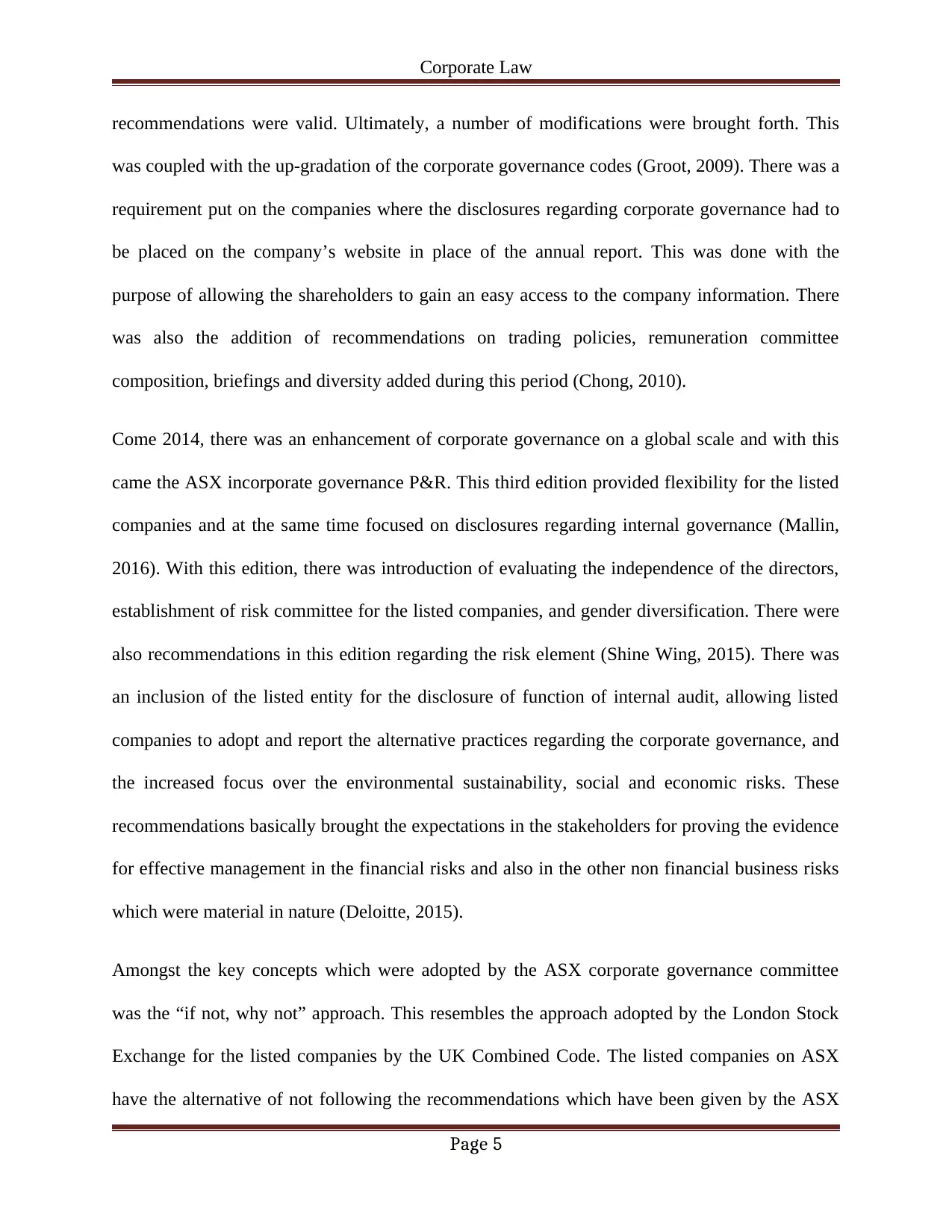
Corporate Law
recommendations were valid. Ultimately, a number of modifications were brought forth. This
was coupled with the up-gradation of the corporate governance codes (Groot, 2009). There was a
requirement put on the companies where the disclosures regarding corporate governance had to
be placed on the company’s website in place of the annual report. This was done with the
purpose of allowing the shareholders to gain an easy access to the company information. There
was also the addition of recommendations on trading policies, remuneration committee
composition, briefings and diversity added during this period (Chong, 2010).
Come 2014, there was an enhancement of corporate governance on a global scale and with this
came the ASX incorporate governance P&R. This third edition provided flexibility for the listed
companies and at the same time focused on disclosures regarding internal governance (Mallin,
2016). With this edition, there was introduction of evaluating the independence of the directors,
establishment of risk committee for the listed companies, and gender diversification. There were
also recommendations in this edition regarding the risk element (Shine Wing, 2015). There was
an inclusion of the listed entity for the disclosure of function of internal audit, allowing listed
companies to adopt and report the alternative practices regarding the corporate governance, and
the increased focus over the environmental sustainability, social and economic risks. These
recommendations basically brought the expectations in the stakeholders for proving the evidence
for effective management in the financial risks and also in the other non financial business risks
which were material in nature (Deloitte, 2015).
Amongst the key concepts which were adopted by the ASX corporate governance committee
was the “if not, why not” approach. This resembles the approach adopted by the London Stock
Exchange for the listed companies by the UK Combined Code. The listed companies on ASX
have the alternative of not following the recommendations which have been given by the ASX
Page 5
recommendations were valid. Ultimately, a number of modifications were brought forth. This
was coupled with the up-gradation of the corporate governance codes (Groot, 2009). There was a
requirement put on the companies where the disclosures regarding corporate governance had to
be placed on the company’s website in place of the annual report. This was done with the
purpose of allowing the shareholders to gain an easy access to the company information. There
was also the addition of recommendations on trading policies, remuneration committee
composition, briefings and diversity added during this period (Chong, 2010).
Come 2014, there was an enhancement of corporate governance on a global scale and with this
came the ASX incorporate governance P&R. This third edition provided flexibility for the listed
companies and at the same time focused on disclosures regarding internal governance (Mallin,
2016). With this edition, there was introduction of evaluating the independence of the directors,
establishment of risk committee for the listed companies, and gender diversification. There were
also recommendations in this edition regarding the risk element (Shine Wing, 2015). There was
an inclusion of the listed entity for the disclosure of function of internal audit, allowing listed
companies to adopt and report the alternative practices regarding the corporate governance, and
the increased focus over the environmental sustainability, social and economic risks. These
recommendations basically brought the expectations in the stakeholders for proving the evidence
for effective management in the financial risks and also in the other non financial business risks
which were material in nature (Deloitte, 2015).
Amongst the key concepts which were adopted by the ASX corporate governance committee
was the “if not, why not” approach. This resembles the approach adopted by the London Stock
Exchange for the listed companies by the UK Combined Code. The listed companies on ASX
have the alternative of not following the recommendations which have been given by the ASX
Page 5
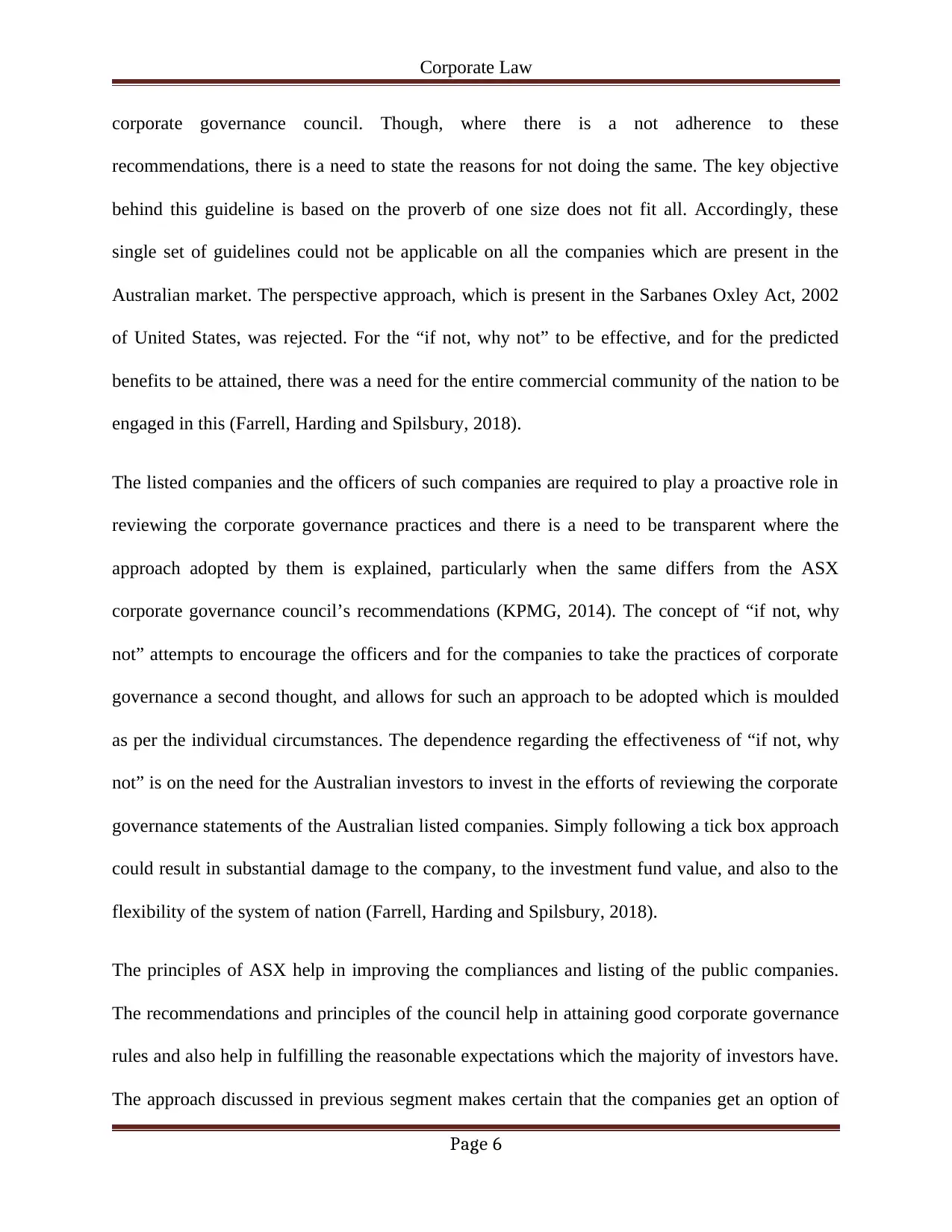
Corporate Law
corporate governance council. Though, where there is a not adherence to these
recommendations, there is a need to state the reasons for not doing the same. The key objective
behind this guideline is based on the proverb of one size does not fit all. Accordingly, these
single set of guidelines could not be applicable on all the companies which are present in the
Australian market. The perspective approach, which is present in the Sarbanes Oxley Act, 2002
of United States, was rejected. For the “if not, why not” to be effective, and for the predicted
benefits to be attained, there was a need for the entire commercial community of the nation to be
engaged in this (Farrell, Harding and Spilsbury, 2018).
The listed companies and the officers of such companies are required to play a proactive role in
reviewing the corporate governance practices and there is a need to be transparent where the
approach adopted by them is explained, particularly when the same differs from the ASX
corporate governance council’s recommendations (KPMG, 2014). The concept of “if not, why
not” attempts to encourage the officers and for the companies to take the practices of corporate
governance a second thought, and allows for such an approach to be adopted which is moulded
as per the individual circumstances. The dependence regarding the effectiveness of “if not, why
not” is on the need for the Australian investors to invest in the efforts of reviewing the corporate
governance statements of the Australian listed companies. Simply following a tick box approach
could result in substantial damage to the company, to the investment fund value, and also to the
flexibility of the system of nation (Farrell, Harding and Spilsbury, 2018).
The principles of ASX help in improving the compliances and listing of the public companies.
The recommendations and principles of the council help in attaining good corporate governance
rules and also help in fulfilling the reasonable expectations which the majority of investors have.
The approach discussed in previous segment makes certain that the companies get an option of
Page 6
corporate governance council. Though, where there is a not adherence to these
recommendations, there is a need to state the reasons for not doing the same. The key objective
behind this guideline is based on the proverb of one size does not fit all. Accordingly, these
single set of guidelines could not be applicable on all the companies which are present in the
Australian market. The perspective approach, which is present in the Sarbanes Oxley Act, 2002
of United States, was rejected. For the “if not, why not” to be effective, and for the predicted
benefits to be attained, there was a need for the entire commercial community of the nation to be
engaged in this (Farrell, Harding and Spilsbury, 2018).
The listed companies and the officers of such companies are required to play a proactive role in
reviewing the corporate governance practices and there is a need to be transparent where the
approach adopted by them is explained, particularly when the same differs from the ASX
corporate governance council’s recommendations (KPMG, 2014). The concept of “if not, why
not” attempts to encourage the officers and for the companies to take the practices of corporate
governance a second thought, and allows for such an approach to be adopted which is moulded
as per the individual circumstances. The dependence regarding the effectiveness of “if not, why
not” is on the need for the Australian investors to invest in the efforts of reviewing the corporate
governance statements of the Australian listed companies. Simply following a tick box approach
could result in substantial damage to the company, to the investment fund value, and also to the
flexibility of the system of nation (Farrell, Harding and Spilsbury, 2018).
The principles of ASX help in improving the compliances and listing of the public companies.
The recommendations and principles of the council help in attaining good corporate governance
rules and also help in fulfilling the reasonable expectations which the majority of investors have.
The approach discussed in previous segment makes certain that the companies get an option of
Page 6
⊘ This is a preview!⊘
Do you want full access?
Subscribe today to unlock all pages.

Trusted by 1+ million students worldwide
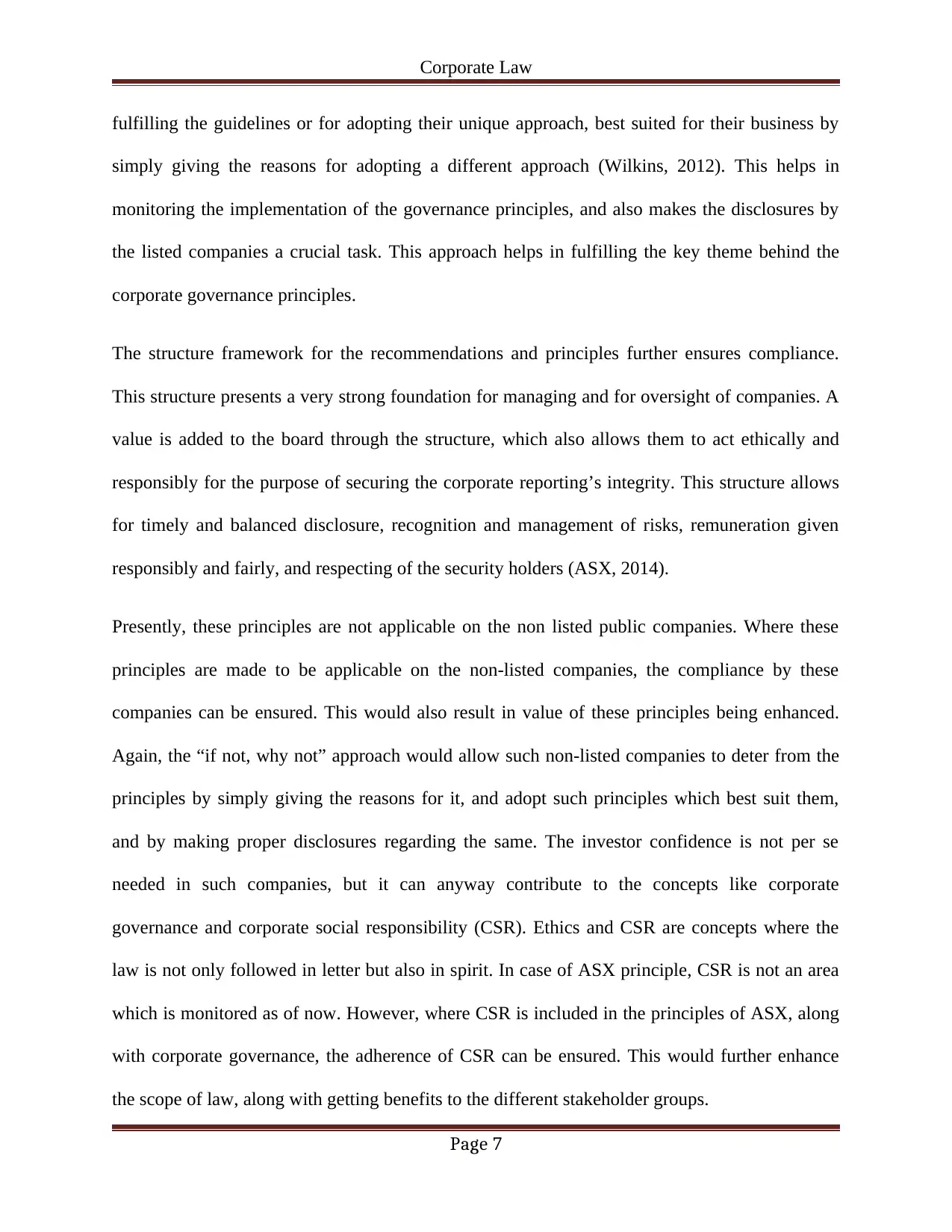
Corporate Law
fulfilling the guidelines or for adopting their unique approach, best suited for their business by
simply giving the reasons for adopting a different approach (Wilkins, 2012). This helps in
monitoring the implementation of the governance principles, and also makes the disclosures by
the listed companies a crucial task. This approach helps in fulfilling the key theme behind the
corporate governance principles.
The structure framework for the recommendations and principles further ensures compliance.
This structure presents a very strong foundation for managing and for oversight of companies. A
value is added to the board through the structure, which also allows them to act ethically and
responsibly for the purpose of securing the corporate reporting’s integrity. This structure allows
for timely and balanced disclosure, recognition and management of risks, remuneration given
responsibly and fairly, and respecting of the security holders (ASX, 2014).
Presently, these principles are not applicable on the non listed public companies. Where these
principles are made to be applicable on the non-listed companies, the compliance by these
companies can be ensured. This would also result in value of these principles being enhanced.
Again, the “if not, why not” approach would allow such non-listed companies to deter from the
principles by simply giving the reasons for it, and adopt such principles which best suit them,
and by making proper disclosures regarding the same. The investor confidence is not per se
needed in such companies, but it can anyway contribute to the concepts like corporate
governance and corporate social responsibility (CSR). Ethics and CSR are concepts where the
law is not only followed in letter but also in spirit. In case of ASX principle, CSR is not an area
which is monitored as of now. However, where CSR is included in the principles of ASX, along
with corporate governance, the adherence of CSR can be ensured. This would further enhance
the scope of law, along with getting benefits to the different stakeholder groups.
Page 7
fulfilling the guidelines or for adopting their unique approach, best suited for their business by
simply giving the reasons for adopting a different approach (Wilkins, 2012). This helps in
monitoring the implementation of the governance principles, and also makes the disclosures by
the listed companies a crucial task. This approach helps in fulfilling the key theme behind the
corporate governance principles.
The structure framework for the recommendations and principles further ensures compliance.
This structure presents a very strong foundation for managing and for oversight of companies. A
value is added to the board through the structure, which also allows them to act ethically and
responsibly for the purpose of securing the corporate reporting’s integrity. This structure allows
for timely and balanced disclosure, recognition and management of risks, remuneration given
responsibly and fairly, and respecting of the security holders (ASX, 2014).
Presently, these principles are not applicable on the non listed public companies. Where these
principles are made to be applicable on the non-listed companies, the compliance by these
companies can be ensured. This would also result in value of these principles being enhanced.
Again, the “if not, why not” approach would allow such non-listed companies to deter from the
principles by simply giving the reasons for it, and adopt such principles which best suit them,
and by making proper disclosures regarding the same. The investor confidence is not per se
needed in such companies, but it can anyway contribute to the concepts like corporate
governance and corporate social responsibility (CSR). Ethics and CSR are concepts where the
law is not only followed in letter but also in spirit. In case of ASX principle, CSR is not an area
which is monitored as of now. However, where CSR is included in the principles of ASX, along
with corporate governance, the adherence of CSR can be ensured. This would further enhance
the scope of law, along with getting benefits to the different stakeholder groups.
Page 7
Paraphrase This Document
Need a fresh take? Get an instant paraphrase of this document with our AI Paraphraser
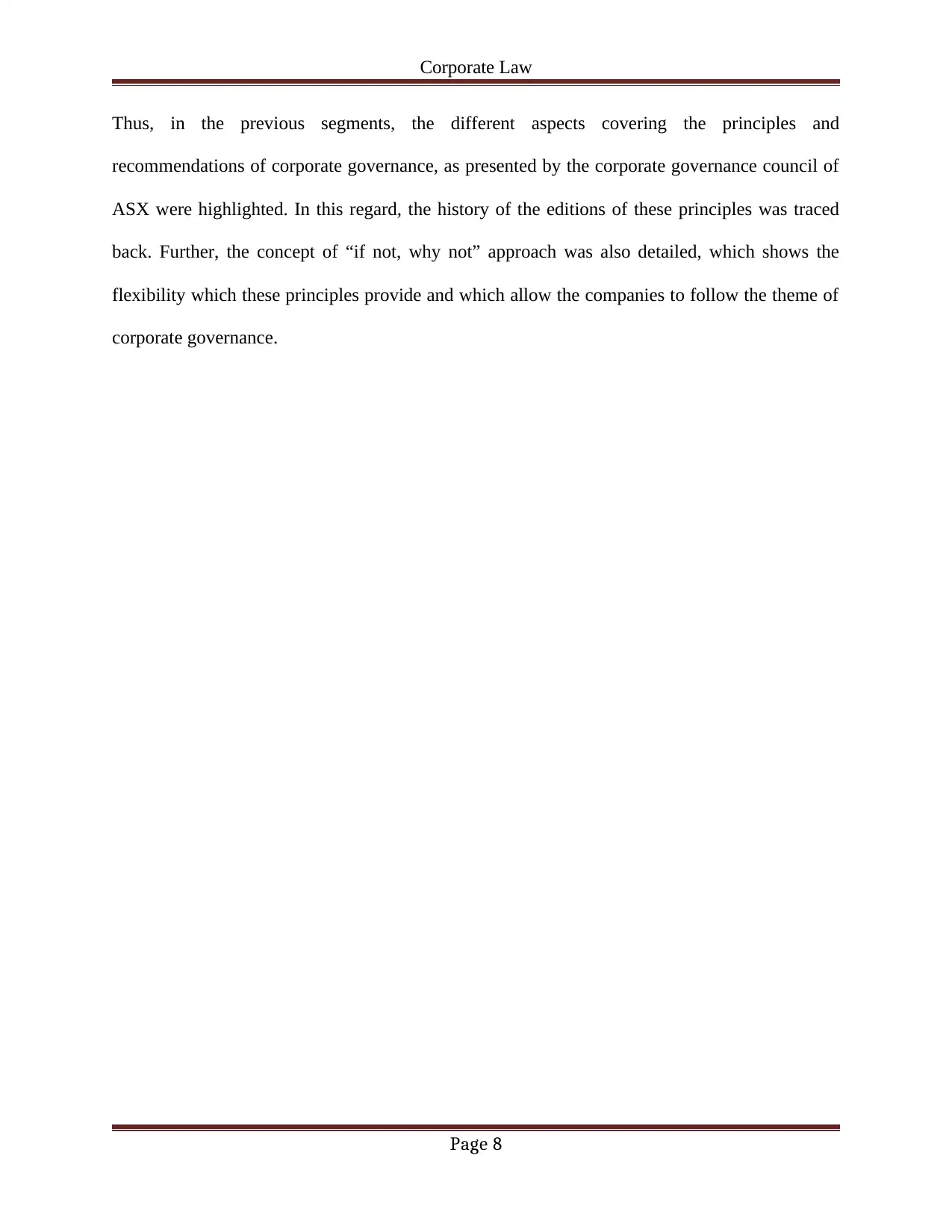
Corporate Law
Thus, in the previous segments, the different aspects covering the principles and
recommendations of corporate governance, as presented by the corporate governance council of
ASX were highlighted. In this regard, the history of the editions of these principles was traced
back. Further, the concept of “if not, why not” approach was also detailed, which shows the
flexibility which these principles provide and which allow the companies to follow the theme of
corporate governance.
Page 8
Thus, in the previous segments, the different aspects covering the principles and
recommendations of corporate governance, as presented by the corporate governance council of
ASX were highlighted. In this regard, the history of the editions of these principles was traced
back. Further, the concept of “if not, why not” approach was also detailed, which shows the
flexibility which these principles provide and which allow the companies to follow the theme of
corporate governance.
Page 8
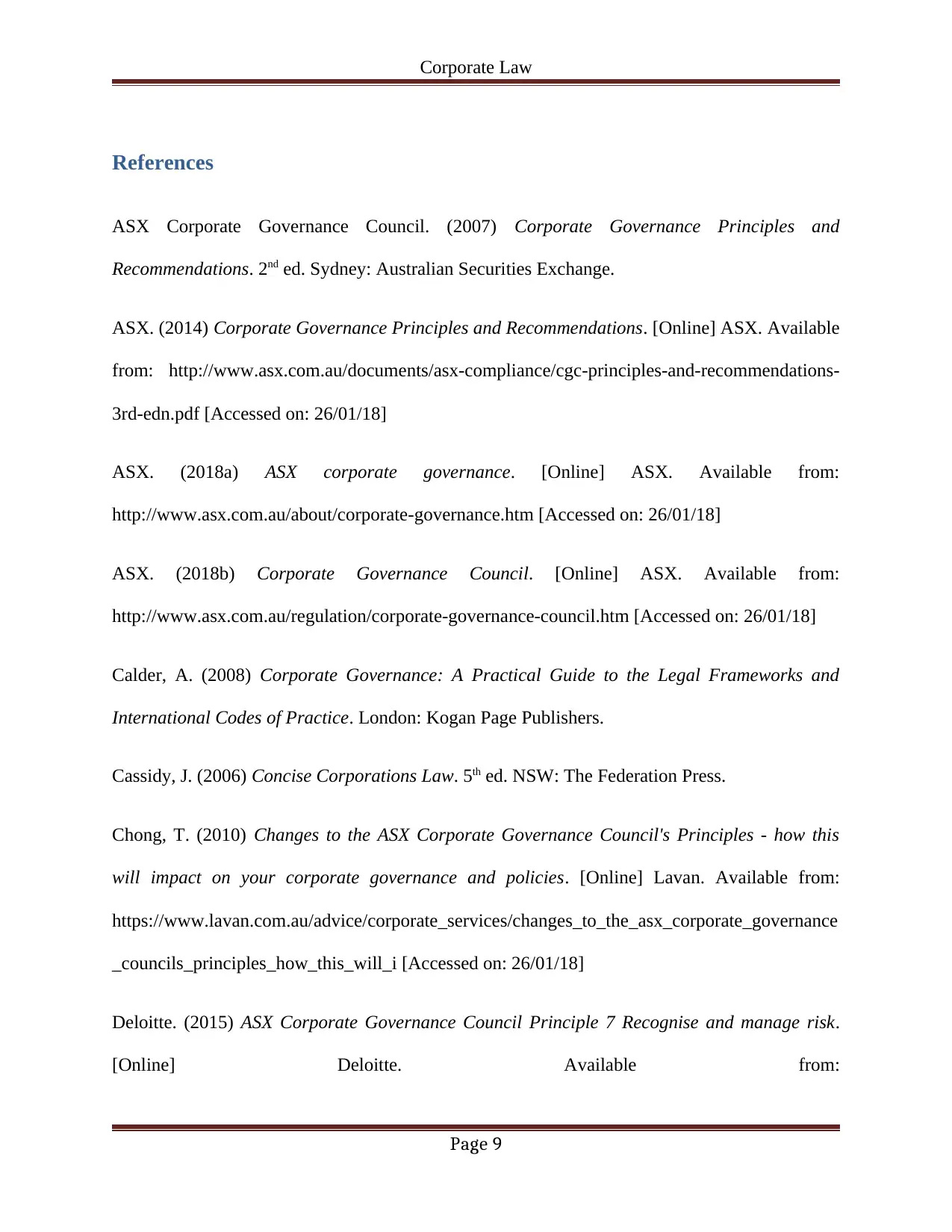
Corporate Law
References
ASX Corporate Governance Council. (2007) Corporate Governance Principles and
Recommendations. 2nd ed. Sydney: Australian Securities Exchange.
ASX. (2014) Corporate Governance Principles and Recommendations. [Online] ASX. Available
from: http://www.asx.com.au/documents/asx-compliance/cgc-principles-and-recommendations-
3rd-edn.pdf [Accessed on: 26/01/18]
ASX. (2018a) ASX corporate governance. [Online] ASX. Available from:
http://www.asx.com.au/about/corporate-governance.htm [Accessed on: 26/01/18]
ASX. (2018b) Corporate Governance Council. [Online] ASX. Available from:
http://www.asx.com.au/regulation/corporate-governance-council.htm [Accessed on: 26/01/18]
Calder, A. (2008) Corporate Governance: A Practical Guide to the Legal Frameworks and
International Codes of Practice. London: Kogan Page Publishers.
Cassidy, J. (2006) Concise Corporations Law. 5th ed. NSW: The Federation Press.
Chong, T. (2010) Changes to the ASX Corporate Governance Council's Principles - how this
will impact on your corporate governance and policies. [Online] Lavan. Available from:
https://www.lavan.com.au/advice/corporate_services/changes_to_the_asx_corporate_governance
_councils_principles_how_this_will_i [Accessed on: 26/01/18]
Deloitte. (2015) ASX Corporate Governance Council Principle 7 Recognise and manage risk.
[Online] Deloitte. Available from:
Page 9
References
ASX Corporate Governance Council. (2007) Corporate Governance Principles and
Recommendations. 2nd ed. Sydney: Australian Securities Exchange.
ASX. (2014) Corporate Governance Principles and Recommendations. [Online] ASX. Available
from: http://www.asx.com.au/documents/asx-compliance/cgc-principles-and-recommendations-
3rd-edn.pdf [Accessed on: 26/01/18]
ASX. (2018a) ASX corporate governance. [Online] ASX. Available from:
http://www.asx.com.au/about/corporate-governance.htm [Accessed on: 26/01/18]
ASX. (2018b) Corporate Governance Council. [Online] ASX. Available from:
http://www.asx.com.au/regulation/corporate-governance-council.htm [Accessed on: 26/01/18]
Calder, A. (2008) Corporate Governance: A Practical Guide to the Legal Frameworks and
International Codes of Practice. London: Kogan Page Publishers.
Cassidy, J. (2006) Concise Corporations Law. 5th ed. NSW: The Federation Press.
Chong, T. (2010) Changes to the ASX Corporate Governance Council's Principles - how this
will impact on your corporate governance and policies. [Online] Lavan. Available from:
https://www.lavan.com.au/advice/corporate_services/changes_to_the_asx_corporate_governance
_councils_principles_how_this_will_i [Accessed on: 26/01/18]
Deloitte. (2015) ASX Corporate Governance Council Principle 7 Recognise and manage risk.
[Online] Deloitte. Available from:
Page 9
⊘ This is a preview!⊘
Do you want full access?
Subscribe today to unlock all pages.

Trusted by 1+ million students worldwide
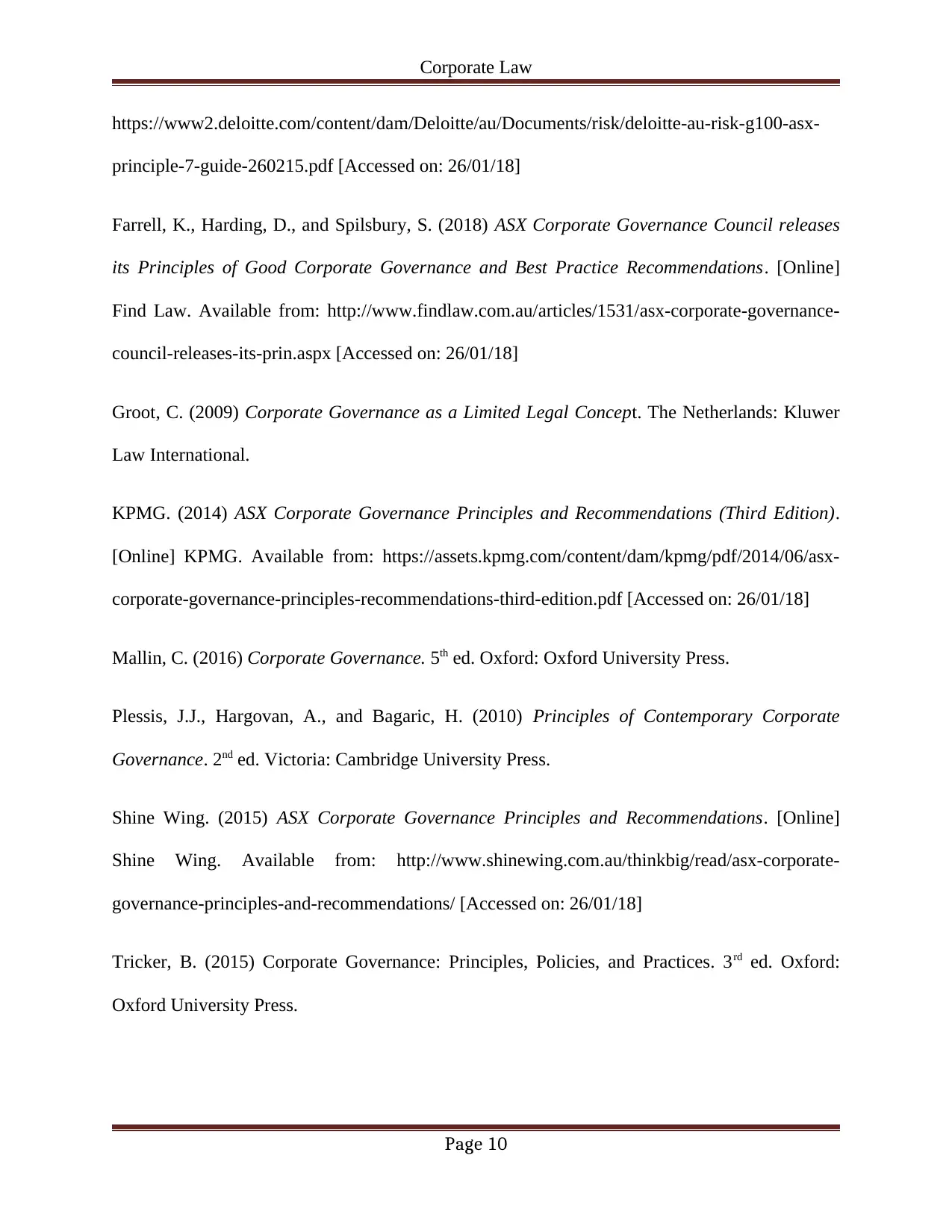
Corporate Law
https://www2.deloitte.com/content/dam/Deloitte/au/Documents/risk/deloitte-au-risk-g100-asx-
principle-7-guide-260215.pdf [Accessed on: 26/01/18]
Farrell, K., Harding, D., and Spilsbury, S. (2018) ASX Corporate Governance Council releases
its Principles of Good Corporate Governance and Best Practice Recommendations. [Online]
Find Law. Available from: http://www.findlaw.com.au/articles/1531/asx-corporate-governance-
council-releases-its-prin.aspx [Accessed on: 26/01/18]
Groot, C. (2009) Corporate Governance as a Limited Legal Concept. The Netherlands: Kluwer
Law International.
KPMG. (2014) ASX Corporate Governance Principles and Recommendations (Third Edition).
[Online] KPMG. Available from: https://assets.kpmg.com/content/dam/kpmg/pdf/2014/06/asx-
corporate-governance-principles-recommendations-third-edition.pdf [Accessed on: 26/01/18]
Mallin, C. (2016) Corporate Governance. 5th ed. Oxford: Oxford University Press.
Plessis, J.J., Hargovan, A., and Bagaric, H. (2010) Principles of Contemporary Corporate
Governance. 2nd ed. Victoria: Cambridge University Press.
Shine Wing. (2015) ASX Corporate Governance Principles and Recommendations. [Online]
Shine Wing. Available from: http://www.shinewing.com.au/thinkbig/read/asx-corporate-
governance-principles-and-recommendations/ [Accessed on: 26/01/18]
Tricker, B. (2015) Corporate Governance: Principles, Policies, and Practices. 3rd ed. Oxford:
Oxford University Press.
Page 10
https://www2.deloitte.com/content/dam/Deloitte/au/Documents/risk/deloitte-au-risk-g100-asx-
principle-7-guide-260215.pdf [Accessed on: 26/01/18]
Farrell, K., Harding, D., and Spilsbury, S. (2018) ASX Corporate Governance Council releases
its Principles of Good Corporate Governance and Best Practice Recommendations. [Online]
Find Law. Available from: http://www.findlaw.com.au/articles/1531/asx-corporate-governance-
council-releases-its-prin.aspx [Accessed on: 26/01/18]
Groot, C. (2009) Corporate Governance as a Limited Legal Concept. The Netherlands: Kluwer
Law International.
KPMG. (2014) ASX Corporate Governance Principles and Recommendations (Third Edition).
[Online] KPMG. Available from: https://assets.kpmg.com/content/dam/kpmg/pdf/2014/06/asx-
corporate-governance-principles-recommendations-third-edition.pdf [Accessed on: 26/01/18]
Mallin, C. (2016) Corporate Governance. 5th ed. Oxford: Oxford University Press.
Plessis, J.J., Hargovan, A., and Bagaric, H. (2010) Principles of Contemporary Corporate
Governance. 2nd ed. Victoria: Cambridge University Press.
Shine Wing. (2015) ASX Corporate Governance Principles and Recommendations. [Online]
Shine Wing. Available from: http://www.shinewing.com.au/thinkbig/read/asx-corporate-
governance-principles-and-recommendations/ [Accessed on: 26/01/18]
Tricker, B. (2015) Corporate Governance: Principles, Policies, and Practices. 3rd ed. Oxford:
Oxford University Press.
Page 10
Paraphrase This Document
Need a fresh take? Get an instant paraphrase of this document with our AI Paraphraser

Corporate Law
Wilkins, G. (2012) What is the 'two-strikes' rule?. [Online] The Sydney Morning Herald.
Available from: http://www.smh.com.au/business/agm-season/what-is-the-twostrikes-rule-
20121008-278us.html [Accessed on: 26/01/18]
Page 11
Wilkins, G. (2012) What is the 'two-strikes' rule?. [Online] The Sydney Morning Herald.
Available from: http://www.smh.com.au/business/agm-season/what-is-the-twostrikes-rule-
20121008-278us.html [Accessed on: 26/01/18]
Page 11
1 out of 11
Related Documents
Your All-in-One AI-Powered Toolkit for Academic Success.
+13062052269
info@desklib.com
Available 24*7 on WhatsApp / Email
![[object Object]](/_next/static/media/star-bottom.7253800d.svg)
Unlock your academic potential
Copyright © 2020–2025 A2Z Services. All Rights Reserved. Developed and managed by ZUCOL.





